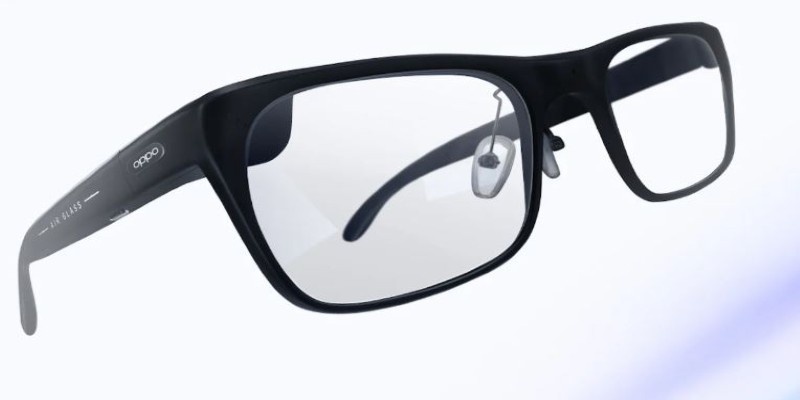Advertisement
Virtual reality has moved from sci-fi movies to everyday life, and the Air Glass 3 XR by Oppo is one more step in that direction. These new AI-powered glasses blend digital features with your real surroundings, helping people interact with technology more naturally. Whether you’re using them for work, learning, or entertainment, Oppo’s latest device shows how fast smart wearables are growing.
The Air Glass 3 XR is built to be lightweight, smart, and useful, all while staying comfortable to wear. These glasses aren’t just for showing off—Oppo wants them to actually help people with daily tasks. The focus on AI gives users tools that feel more human and more helpful than before.
The Air Glass 3 XR blends a digital screen into a set of glasses that looks and feels like regular eyewear. But what makes it different is its use of artificial intelligence to give users a smooth experience. You can ask questions, get directions, or even control smart home tools, all with your voice or simple gestures.
At the core of the glasses is Oppo's in-house AI assistant. It's designed to listen and respond quickly. You no longer need to peek down at a phone. The glasses project important information right in front of your eyes—such as who's calling, how the weather is, or what's coming up on your calendar. This is supposed to keep your attention on the world, not on your screen.
One of the major upgrades for the Air Glass 3 XR is screen sharpness. Oppo employs the latest display technology to ensure that the picture remains sharp and bright outside, too. That way, you can observe messages, guiding arrows, or any other data without squinting or nodding your head.
The glasses also use microphones that cancel noise and pick up your voice clearly. This makes it easier to talk to the AI, even in noisy places like train stations or busy cafes. Whether you’re checking reminders or answering messages, the smart features are built to feel smooth and quick.
Oppo worked hard to keep the design simple and light. Many smart glasses before this felt bulky or too futuristic. The Air Glass 3 XR looks more like everyday glasses, which means people can wear them in public without feeling out of place.

Weight matters in something you wear on your face all day. These glasses are lighter than many smartphones, which reduces strain. This makes them usable for long hours, whether you're reading news updates or listening to voice notes.
The frame holds speakers that send sound directly toward your ears using something called "directional audio." This lets you hear music or replies from the assistant without others around you noticing. It’s a more private and less distracting way to use audio in public.
Another important feature is the easy way it connects with smartphones. Right now, it works best with Oppo phones, but future updates may open the door for other Android users. With a single tap, the glasses sync with your device, giving you access to messages, navigation, and smart replies.
Oppo’s new glasses are designed to help people in real life—not just in labs or games. The AI-powered VR glasses make tasks like translation, voice-to-text, or note-taking more natural. Say you’re traveling and need directions; you can just ask, and the guidance appears right on the lens.
If you’re attending a work event or class, the Air Glass 3 XR can show live captions of what's being said. This helps with learning and accessibility. It’s not about fancy tricks—it’s about making smart tools that people can use every day.
The glasses also support reminders and calendar events that pop up without needing to pull out your phone. Since AI handles many of the tasks, it understands context better—like knowing if you're walking or driving and adjusting what it shows you.
For people with hearing issues or language barriers, the Air Glass 3 XR offers real help. Translations and captions show up clearly and are powered by the AI backend. These features can help make the world easier to follow and understand.
Even simple tasks—like checking the weather, replying to a quick message, or hearing your shopping list—are faster when you don’t have to stop and scroll. The AI behind the glasses learns from your habits and gets better over time.
Oppo isn’t the only company in this space, but the Air Glass 3 XR stands out for how well it fits into daily life. It doesn’t try to replace your phone or computer—it works alongside them, helping with tasks that need to be fast and hands-free.

While the glasses still rely on being connected to a phone for many tasks, they give a glimpse of where smart wearables are going. The goal isn’t just to impress with tech but to make life simpler. As future updates roll out, we can expect the glasses to become more open, more compatible, and even more useful.
The Air Glass 3 XR also shows how AI can feel more human. With a voice assistant that responds fast, tools that adjust based on your environment, and a design that fits in with normal life, Oppo is offering something that isn’t just new—it’s actually usable.
With better battery life and improved display quality than the last model, this is not a half-step. It’s a clear move forward. For people who like trying new tools or want help staying organized, this product could be a strong fit.
The Air Glass 3 XR shows how AI and design can work together to make tech more natural. Oppo’s smart glasses aren't trying to be flashy—they're built to be helpful. Whether it’s showing live directions, taking voice notes, or making everyday tasks easier, this new device keeps things simple and smooth.
By focusing on real needs like voice help, screen clarity, and comfort, Oppo proves that smart wearables don’t need to be a sci-fi dream. They can be tools we use right now.
Advertisement

Explore how artificial intelligence improves safety, health, and compliance in manufacturing through smarter EHS systems.

How to enhance RAG performance with CRAG by improving docu-ment ranking and answer quality. This guide explains how the CRAG method works within the RAG pipeline to deliver smarter, more accurate AI responses using better AI retrieval techniques

Wondering how AI finds meaning in messy data? Learn how vector databases power similarity search, make tools smarter, and support real-time AI features

How to convert string to a list in Python using practical methods. Explore Python string to list methods that work for words, characters, numbers, and structured data

Learn how to build Custom GPTs using this step-by-step guide—perfect for developers, businesses, and AI enthusiasts alike.

Explore the core technology behind ChatGPT and similar LLMs, including training methods and how they generate text.

In this article, we talk about the types of neural networks. CNN vs RNN vs ANN, and how are they all different.

Struggling with bugs or confusing code? Blackbox AI helps developers solve coding problems quickly with real-time suggestions, explanations, and code generation support

How to translate your audio using Rask AI to create multilingual voiceovers and subtitles with ease. Discover how this AI tool helps globalize your content fast

Alluxio debuts a new orchestration layer designed to speed up data access and workflows for AI and ML workloads.

How to handle NZEC (Non-Zero Exit Code) errors in Python with be-ginner-friendly steps and clear examples. Solve common runtime issues with ease

Discover how ChatGPT can help Dungeon Masters and players enhance their Dungeons and Dragons experience by generating NPCs, plot hooks, combat encounters, and world lore